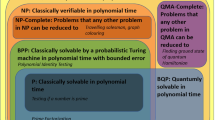Abstract
We present a fast parallel SAT-solver on a message based MIMD machine. The input formula is dynamically divided into disjoint subformulas. Small subformulas are solved by a fast sequential SAT-solver running on every processor, which is based on the Davis-Putnam procedure with a special heuristic for variable selection. The algorithm uses optimized data structures to modify Boolean formulas. Additionally efficient workload balancing algorithms are used, to achieve a uniform distribution of workload among the processors. We consider the communication network topologiesd-dimensional processor grid and linear processor array. Tests with up to 256 processors have shown very good efficiency-values (>0.95).
Similar content being viewed by others
References
M. Buro and H. Kleine Büning, Report on a SAT competition,EATCS Bulletin, No. 49 (February, 1993) 143–151.
A. Frieze and S. Suen, Analysis of two simple heuristics on a random instance ofk-SAT, to appear inJournal of Algorithms (1996).
L.M. Kirousis, E. Kranakis and D. Krizanc, Approximating the unsatisfiability threshold of random formulas, Carleton University, School of Computer Science, TR-95-26 (1995).
S.A. Cook, The complexity of theorem-proving procedures,Proceedings of the 3rd Annual ACM Symposium on Theory of Computing (1971) pp. 151–158.
J.M. Crawford and L.D. Auton,Experimental Results on the Crossover Point in Satisfiability Problems (DIMACS, Rutgers University, New Brunswick, NJ 08903, 1993).
M. Davis and H. Putnam, A computing procedure for quantification theory,J. Assoc. Comput. Mach. 7 (1960) 201–215.
W. Dowling and J. Gallier, Linear-time algorithms for testing the satisfiability of propositional Horn formulae,J. Logic Programming 3 (1984) 267–284.
O. Dubois, P. Andre, Y. Boufkhad and J. Carlier,Can a Very Simple Algorithm be Efficient for Solving the SAT Problem? (DIMACS, Rutgers University, New Brunswick, NJ 08903, 1993).
J. Franco, Elimination of infrequent variables improves average case performance of satisfiability,SIAM J. Comput. 20 (1991) 1119–1127.
I.P. Gent and T. Walsh,Towards an Understanding of Hill-climbing Procedures for SAT (DIMACS, Rutgers University, New Brunswick, NJ 08903, 1993).
A. Haken, The intractability of resolution,Theor. Comput. Sci. 39 (1985) 297–308.
P. Heusch,Implikationen der Implikation, Dissertation, Mathematisches Institut, Heinrich-Heine-Universität-Düsseldorf (1993).
D. Johnson and M. Trick, eds,The DIMACS Challenge on Satisfiability Testing (DIMACS, Rutgers University, New Brunswick, NJ 08903, 1993).
D. Mitchell, B. Selman and H. Levesque, Hard and easy distributions of SAT problems,Proc. AAAI-92, San Jose, CA (July, 1992) pp. 459–465.
B. Monien and E. Speckenmeyer, Solving satisfiability in less than 2n steps,Discrete Applied Mathematics 10 (1985) 287–295.
P.W. Purdom, Jr. and N.G. Haven, Backtracking and probing, Indiana University Computer Science, Technical Report No. 387 (1993).
B. Selman, H. Levesque and D. Mitchell, A new method for solving hard satisfiability problems,Proc. AAAI-92, San Jose, CA (July, 1992) pp. 440–446.
E. Speckenmeyer, Is average superlinear speedup possible?,Proc. CSL '88, LNCS 385, Springer-Verlag (1989) pp. 301–312.
G.S. Tseitin, On the complexity of derivation in propositional calculus,Studies in Constructive Mathematics and Mathematical Logic, ed. A.O. Slisenko, Part II (translated from Russian) (Consultants Bureau, New York, 1970) pp. 115–125.
Author information
Authors and Affiliations
Additional information
This research was supported by the Federal State of Nordrhein-Westfalen in theForschungsverbund Paralleles Rechnen, Az., IV A3-107 021 91.
Rights and permissions
About this article
Cite this article
Böhm, M., Speckenmeyer, E. A fast parallel SAT-solver — efficient workload balancing. Ann Math Artif Intell 17, 381–400 (1996). https://doi.org/10.1007/BF02127976
Issue Date:
DOI: https://doi.org/10.1007/BF02127976




